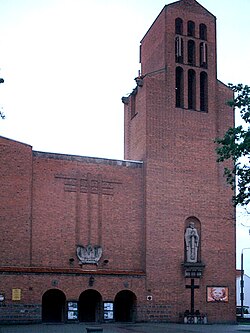Tuchel
| Tuchola | |||
|---|---|---|---|

Church of Corpus Christi (1935-39), Tuchola
|
|||
|
|||
| Coordinates: 53°36′N 17°51′E / 53.600°N 17.850°E | |||
| Country |
|
||
| Voivodeship | Kuyavian-Pomeranian | ||
| County | Tuchola County | ||
| Gmina | Gmina Tuchola | ||
| Government | |||
| • Mayor | Tadeusz Henryk Kowalski | ||
| Area | |||
| • Total | 17.69 km2 (6.83 sq mi) | ||
| Population (2012) | |||
| • Total | 20,185 | ||
| • Density | 1,100/km2 (3,000/sq mi) | ||
| Time zone | CET (UTC+1) | ||
| • Summer (DST) | CEST (UTC+2) | ||
| Postal code | 89-500,89-501 | ||
| Car plates | CTU | ||
| Website | http://www.tuchola.pl | ||
Tuchola [tuˈxɔla] (German: Tuchel; Kashubian: Tëchòlô) is a town in the Kuyavian-Pomeranian Voivodeship in northern Poland. The Pomeranian town, which is the seat of Tuchola County, had a population of 13,418 as of 2013[update].
Tuchola lies about 50 kilometres (31 miles) north of Bydgoszcz, close to the Tuchola Forests. Forest areas to the east and north of the town form the protected area of Tuchola Landscape Park.
Settlement around Tuchola dates from 980, while the town was first mentioned in 1287. The place was one of the strongholds of the count of Nowe Peter Swienca, who owned a fortified domicile in the area. In 1330 Tuchola came into possession of the Teutonic Order. It received Culm law in 1346 from Heinrich Dusemer, the Grand Master of the Teutonic Knights.
After the Order's defeat in the Battle of Grunwald on July 14, 1410, a Polish-Lithuanian army captured the town on November 5, 1410, but the Order regained the town in the First Peace of Thorn in 1411. At the end of the Thirteen Years' War (1454–1466), however, it was ceded to Poland in the Second Peace of Thorn and became part of Royal Prussia.
...
Wikipedia



